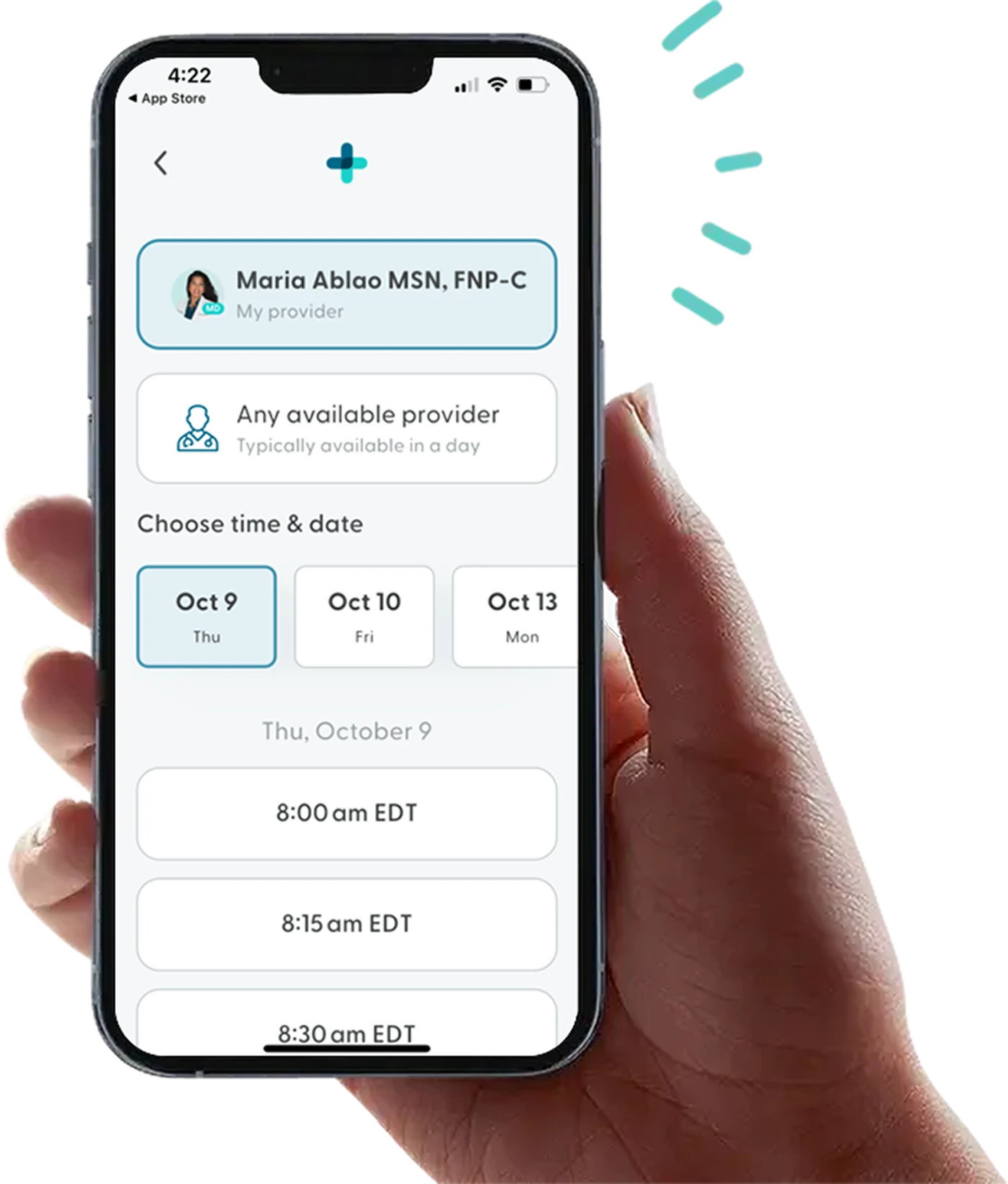What is the Difference Between a Wheat Allergy and Gluten Intolerance?
Many people assume that if they’re allergic to bread or other wheat products, they also have gluten intolerance. However, not everyone with a wheat allergy has gluten intolerance.
People often confuse gluten intolerance with a wheat allergy because gluten is most commonly found in wheat. Gluten is also found in non-wheat foods like barley and rye. However, those with gluten intolerance are more likely to carry the gene for autoimmune conditions like celiac disease.
Many of the symptoms of a wheat allergy and gluten intolerance overlap, but some are slightly different. This is because gluten intolerance and wheat allergy trigger different responses from the immune system.
Food allergies affecting your daily life?
Speak to a healthcare provider online about your allergy symptoms today.


What is Gluten Intolerance?
Gluten intolerance (gluten sensitivity) is when the digestive system reacts negatively to gluten exposure. Gluten is one of the main proteins in wheat grains. It helps to add more texture and flavor to baked goods.
It’s also a nutritious source of protein in bread and other foods. However, the immune system of someone with gluten intolerance perceives gluten as a threat.
Those with gluten intolerance may experience acid reflux, bloating, abdominal pain, and other digestive symptoms. Headaches, joint pain, and fatigue are also potential symptoms.
What are Common Sources of Gluten?
Gluten is present in most baked goods. However, people have found ways to produce gluten-free baked goods without sacrificing the texture and consistency of popular desserts and snacks.
Common sources of gluten include:
Bread
Whole grains
Potato chips
Pasta
Cereal
Soup
Beer
Food coloring
Veggie burgers
Foods labeled “gluten-free” contain no gluten or extremely low levels of it. Many foods like bread, pasta, and cereal may contain both wheat and gluten.
Key Point: Do Gluten-Free Foods Have Any Traces of Gluten?
The U.S. Food and Drug Administration (FDA) requires that foods labeled “gluten-free” contain less than 20 ppm (parts per million) of gluten.
Health experts believe this measurement is safest for people with severe gluten allergies. Gluten-free foods must also not contain any type of wheat, barley, or rye.
What is a Wheat Allergy?
While similar, wheat allergy is slightly different from gluten intolerance. Wheat allergy causes an overproduction of antibodies when wheat proteins make contact with the immune system. The main wheat proteins triggering an immune response are albumin, prolamin, globulin, and glutelin.
Those with a wheat allergy may also experience slightly different symptoms than those with gluten intolerance.
A few symptoms you may experience with a wheat allergy include:
Persistent cough
Nausea
Wheezing
Trouble breathing
Hives
Swelling
What are Common Sources of Wheat?
Many common sources of wheat overlap with foods that contain gluten. Be sure to thoroughly read food labels of foods you may not expect to have wheat in them as well. For example, many sauces and salad dressings may contain hidden sources of wheat.
The following foods often contain wheat:
Protein bars
Bread
Beer
Pasta
Flour
Soy sauce
Potato chips
Who is Most Likely to Develop Wheat Allergy or Gluten Intolerance?
One or both parents can pass on the gene for wheat allergy or gluten intolerance. Those with eczema and asthma are also more likely to develop a wheat allergy or gluten intolerance.
People with a family history of celiac disease are more likely to carry the gene for gluten intolerance. Celiac disease is an autoimmune condition that causes digestive symptoms in response to gluten. It's also possible to have non-celiac gluten sensitivity.
If you suspect you have a wheat allergy or gluten intolerance, be sure to reach out to a healthcare provider. Going on a gluten-free diet without an accurate diagnosis can potentially lead to nutritional deficiencies. A gluten-free diet may contain low amounts of fiber, vitamin B12, vitamin D, and other key nutrients.
How is a Gluten Intolerance and Wheat Allergy Diagnosed?
A licensed healthcare provider can perform an allergy test to check for a wheat allergy and other potential allergies. An allergy test is typically done using the skin prick method. However, a skin prick test cannot detect gluten intolerance.
During a skin prick test, a healthcare provider places a small amount of allergens on the surface of the skin. They make sure to carefully monitor you for any physical reactions for about 10-15 minutes afterward. A sign of an allergy may be a feeling of itchiness, a rash, or other symptoms from an allergen making contact.
Blood tests can detect both a wheat allergy and gluten intolerance. A healthcare provider may proactively suggest a blood test during a routine visit for those with a family history of celiac disease or gluten sensitivity.
However, a blood test may not accurately detect a gluten intolerance if the person is not regularly consuming gluten before the test. A healthcare provider may recommend consuming gluten products at least four weeks before the test.
What are the Key Differences Between Wheat Allergy and Gluten Intolerance?
Those with celiac disease or gluten sensitivity need to avoid all proteins related to gluten, whereas those with a wheat allergy only have to avoid wheat.
Unlike wheat, gluten is not considered an allergen. This is why allergy tests cannot detect gluten intolerance, but they can detect a wheat allergy.
Many people mistakenly label gluten an allergen because they experience allergy symptoms when consuming it. A gluten intolerance is most often a sign of health conditions like celiac disease (an autoimmune disorder) and gluten ataxia (a neurological disorder caused by gluten ingestion).
A wheat allergy is triggered by both IgE antibodies and non-IgE antibodies. Gluten intolerance is an immune response to non-IgE antibodies and often leads to damage to the small intestine.
How to Treat a Wheat Allergy and Gluten Intolerance
Not everyone with a wheat allergy needs to avoid gluten. A gluten-free diet can benefit those with gluten intolerance or a wheat allergy because gluten-free products typically don’t contain wheat, barley, and rye.
However, some products listed as gluten-free may still be unsafe for people with gluten intolerance. Be sure to thoroughly read the ingredients on food labels. If still unsure, you can contact the distributor of the packaged food directly to learn more about the presence of gluten in the product.
Where Can I Learn More About Food Allergies?
At LifeMD, you can speak with a licensed healthcare provider about what to do if you suspect you’re allergic to wheat or have a gluten intolerance. They can give you tips for keeping yourself safe during an allergic reaction, safe foods to add to your diet, and instructions on how to follow a gluten-free diet.
Book an appointment today to learn more about managing a wheat allergy or gluten intolerance.
More articles like this
Feel better with LifeMD.
Your doctor is online and ready to see you.
Join LifeMD for seamless, personalized care — combining expert medical guidance, convenient prescriptions, and 24/7 virtual access to urgent and primary care.

 Medically reviewed and edited by
Medically reviewed and edited by 








